In the Ancient American Southwest, Turkeys Were Friends, Not Food
An 800-year-old blanket made out of turkey feathers testifies to the bird’s significance in Pueblo culture
:focal(678x432:679x433)/https://tf-cmsv2-smithsonianmag-media.s3.amazonaws.com/filer/21/86/2186047c-9b4d-4c3c-8827-afc8eb336237/turkey_feather_blanket.jpg)
A blanket made by early 13th-century Indigenous peoples in what is now the southwestern United States featured more than 11,000 turkey feathers woven into almost 200 yards of yucca fiber, new research shows. The findings—published in the Journal of Archaeological Science: Reports—shed light on cultural practices among the ancestral Puebloans, forebears of modern Hopi, Zuni and Rio Grande Pueblo nations, reports Jennifer Ouellette for Ars Technica.
The researchers say the region’s people began to switch from blankets made of rabbit skin strips to turkey-feather designs during the first two centuries A.D.
“As ancestral Pueblo farming populations flourished, many thousands of feather blankets would likely have been in circulation at any one time,” says co-author Shannon Tushingham, an anthropologist at Washington State University (WSU), in a statement. “It is likely that every member of an ancestral Pueblo community, from infants to adults, possessed one.”
Though the region’s early inhabitants had farmed turkeys prior to the 12th century, they only started using the birds as a food source around 1100 or 1200, when wild game became scarce due to overhunting. Previously, the study’s authors say, people painlessly plucked mature feathers from molting birds. This technique allowed them to harvest feathers several times per year over a bird’s lifetime of 10 years or more. Researchers have found that turkeys were often buried whole, pointing toward their significance to the people who raised them.
“The birds that supplied the feathers were likely being treated as individuals important to the household and would have been buried complete,” says the paper’s lead author, Bill Lipe, also an anthropologist at WSU. “This reverence for turkeys and their feathers is still evident today in Pueblo dances and rituals. They are right up there with eagle feathers as being symbolically and culturally important.”
Per the statement, the researchers conducted their analysis on a blanket from southeastern Utah. On display at the Edge of the Cedars State Park Museum in Blanding, the textile measures 39 by 42.5 inches. Insects have destroyed the cloth’s feather vanes and barbs, but feather shafts wrapped in the woven yucca fiber remain visible, according to Ars Technica. The scientists also examined a smaller intact blanket that appears to be from the same time period. They found that the craftspeople who made the two blankets used body feathers from the birds’ backs and breasts.

The Puebloans’ blanket-making process survives to this day: In 2018, Mary Weahkee, an archaeologist at the New Mexico Department of Cultural Affairs, taught herself to weave turkey-feather blankets using the 1,000-year old technique, reports Alexa Henry for New Mexico Wildlife magazine. Producing a 2- by 3-foot blanket took her 18 months and required 17,000 feathers from 68 turkeys.
“I looked at how the ancestors were creative and patient,” Weahkee, who is of Comanche and Santa Clara descent, tells New Mexico Wildlife. “It’s a labor of love.”
In a video posted by the Museum of Indian Arts and Culture in Santa Fe, Weahkee demonstrates the techniques used to prepare yucca fibers and feathers and weave the blanket.
“The turkey is the only bird that allows feathers to be taken and it won’t bleed,” Weahkee says. “It has a defensive mechanism to where if a predator grabs the feather the skin will literally open up and release the feather at will.”
Weahkee isn’t the only modern researcher working to recreate the technique. Per the study, “[t]he time and skills needed to produce a blanket are beginning to be assessed in a growing number of present-day replication attempts,” including a project by Paul Ermigiotti of Colorado’s Crow Canyon Archaeological Center.
Tushingham says the new research helps flesh out the ways in which ancestral Puebloans worked with turkeys.
“Turkeys were one of the very few domesticated animals in North America until Europeans arrived in the 1500s and 1600s,” she explains. “They had and continue to have a very culturally significant role in the lives of Pueblo people, and our hope is this research helps shed light on this important relationship.”
/https://tf-cmsv2-smithsonianmag-media.s3.amazonaws.com/accounts/headshot/Livia_lg_thumbnail.png)
/https://tf-cmsv2-smithsonianmag-media.s3.amazonaws.com/accounts/headshot/Livia_lg_thumbnail.png)